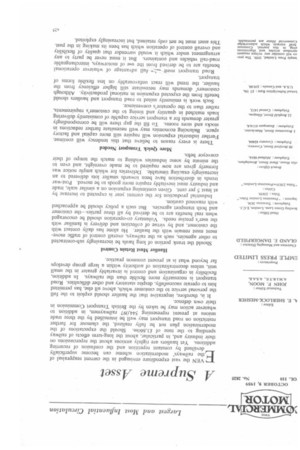A Supreme Asset
Page 27

If you've noticed an error in this article please click here to report it so we can fix it.
EVEN the vast expenditure envisaged in the current reappraisal of the railways' modernization scheme can become superficially devalued by constant repetition and the confusion of recurring additions. Yet hauliers are rightly anxious about the repercussions on their industry and, in particular, about the long-term effects of railway spending to the tune of £1.660m. Should the expectations of the modernization plan not be fully realized, the clamour for further restriction on road transport may well be intensified by the three trade unions at present representing 544,097 railwaymen, in addition to whatever action may be taken by the British Transport Commission in their own defence.
It is, therefore, imperative that the haulier should exploit to the full the personal service to the customer which, above all else, has permitted him to operate successfully, despite statutory and other difficulties. Road transport is necessarily more flexible than the railways. In addition, flexibility in organization and control is invariably greater in the small unit, unless decentralization of authority within a large group develops far beyond what is at present common practice.
Haulier Must Retain Control Should the trunk portion of long hauls be increasingly sub-contracted to other agencies, such as the railways, overall control of traffic movement must remain with the haulier. He alone has daily contact with the customer, and by virtue of collection and delivery is familiar with the user's precise needs. Voluntary co-operation should be encouraged when real benefits are to be derived by all three parties—the customer and both transport agencies. But such a policy should be approached with reasoned caution.
Industrial production for the current year is expected to increase by at least 5 per cent. Given continuing expansion on a similar scale, trade and industry must inevitably require more goods to be moved. Post-war trends in distribution have been towards smaller lots delivered to an increasingly exacting timetable. Deliveries for which ample notice was formerly given are now required to be made overnight, and even to the minute by some industries wishing to match the tempo of their conveyor belts.
More Quick Transport Needed There is every reason to believe that this tendency will continue. Further industrial expansion will require still more capital and factory space. Balancing economies may well necessitate further reductions in stocks and store rooms. To fill the gap there will be correspondingly greater demands for a transport service capable of consistently delivering loads matched in quantity and timing to the customer's requirements, rather than to the operator's convenience.
Such work is eminently suited to road transport and hauliers should benefit from the expected expansion in national productivity. Although customers' demands may necessitate still higher efficiency from the haulier, the trend will react unfavourably on less flexible forms of transport.
Road transport mus't full advantage of whatever operational benefits are to be derived from the uhe of motorways, interchangeable road-rail vehicles and containers. But it must never be party to any arrangement under which it would surrender that quality of flexibility and overall control of operation which has been its making in the past. This asset must be not only retained, but increasingly exploited.




































































































